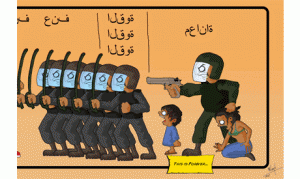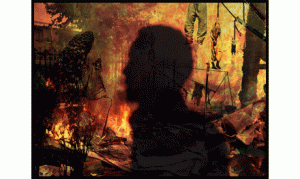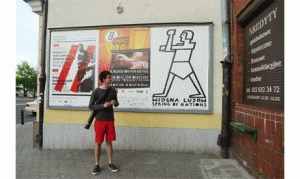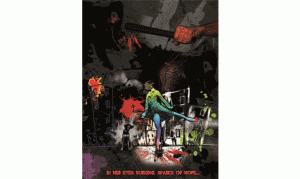When the Egyptian artist Ganzeer called for international artists to support Egypt’s revolution, Polish artists were among the first to rise to the graffiti challenge
Ati Metwaly,
Saturday 21 Jan 2012
11 / 16Gallery
“From January 13 to 25, the streets of Egypt will see an explosion of anti-military street art. If you are a street artist elsewhere in the world, please do what you can in your city to help us. If you’re a comic book artist, a musician, or filmmaker, whatever artistic talent you have can be of big help. If you can do something before the designated date, please do! We need all the help we can get.” — Ganzeer’s blog.
When on 20 December 2011 Egyptian graphic designer and artist Ganzeer (Mohamed Fahmy) posted on his blog “Mad Graffiti Week: An Appeal to Artists Everywhere,” the news spread like wildfire. Artists from Germany, the Czech Republic, Australia, among other countries, joined the initiative. Equally, Polish artists from all around the country expressed their solidarity in creating graffiti, stencils, posters, drawings, and comics, adding their voice to Egypt’s cause.
Sztukatułka, a popular blog on art, translated Ganzeer’s call to Polish asking young creators to join the initiative. The word sztukatułka is a creative fusion of two Polish words: sztuka (art) and a szkatułka (small coffer). The blog was launched February 2011 by Ewelina Karpińska-Morek, an art-lover, promoting a variety of artistic expressions that she finds “creative, surprising or controversial.”
Moreover, Morek is working in one of the major Polish news portals, actively following news about the Arab Spring. Following her visit to Egypt in mid-2011 where she got in touch with revolutionary youth, she wrote an extensive article about how graffiti and street art paralleled sociopolitical changes in Egypt.
“I read Ganzeer’s appeal on his Facebook page,” Morek told Ahram Online. “At first it was an experiment, I didn’t know what to expect. I translated the call and posted it on the blog. To my surprise, many artists responded by sending their work to Sztukatułka.”
For Polish artists, Morek says, the scenes from Egypt’s revolution are not unfamiliar. Older generations participated themselves in a series of uprisings that eventually shattered the communist bloc in 1989. Younger artists listen to the stories told by their parents. “We identify with the Egyptian people; images of security forces beating protesters and military cars crashing the crowd are not unknown to us,” Morek comments. “In a sense, history repeats itself … we see people fighting for their dignity and rights.” Morek created a pop art Warhol-style representation of ousted Egyptian president Hosni Mubarak, the same picture repeated in eight squares across the canvas. The ninth square states: “Man behind bars – Mind the difference.” [picture 1]
Works by many other Polish artists are posted in Sztukatułka. Graduate from the Fine Arts Academy in Warsaw, Kamil Gorgoń, sent his two shocking posters [picture 2]. “Social posters are my favorite form of art, allowing me to respond emotionally to the surrounding reality. My response to Ganzeer is a response to the severe situation of the Egyptian people who, in a sense, find themselves powerless in the face of violence,” Gorgoń told Ahram Online, adding that he does not search for ideological or economical subthemes. Both of his posters stress his opposition to the violence of the Egyptian army towards the people. The first poster shows signs of torture on a man’s back forming the word “Egypt”; the second poster, more metaphoric, depicts a path of blood in the shape of the river Nile.
Gorgoń aims to visually shock his viewer, believing that this way he will incite broader action. His works find positive responses, though one viewer accused him of “promoting violence and depicting images not related to the current situation in Egypt.” On the contrary, many Egyptians shared Gorgoń’s posters on social media platforms, finding them expressive of their current reality and reaction to it.
Michał Klimczyk, a professional cartoonist and creator of popular Polish comics “Acid Drinkers,” heard about Ganzeer’s appeal shortly before Christmas, celebrated in Poland on 25 December. “I could not accept the fact that while we’ll be celebrating Christmas, all those atrocities are happening in Egypt, a country with such a great history. It was Egypt that contributed to the creation of many monotheistic religions and accordingly gave shape to the whole modern world.” Klimczyk believes that staying silent would mean acceptance.
In his work, Klimczyk mimicked Ancient Egyptian drawing techniques, replacing historical characters with protesters facing military forces. One of the officers points a gun at protesters while holding a half-stripped girl by her hair. [pictures 3 and 4]
Frau Ka finds herself best in collages. Her conceptual photography work is based on footage collected from photo-reporters covering Egypt’s events [picture 5]. Flames, strife, chaos and the sufferings of people; the shocking image of war-like reality is this artist’s statement, opposing the way that Egyptian protesters are treated. “I don’t accept beatings, kicking, humiliation, shooting civilians, regardless who and where the victim is. If paintings can call for peace, it’s our role to do that,” Ka commented to Ahram Online.
Jan Bajtlik is a fourth-year student at the Academy of Fine Arts in Warsaw. Using simple, succinct and witty posters, he tries to provoke a reaction from his audience. “This is my commentary on the events. I hope Europe, that is still filled with so many stereotypes about the Arab world, will look differently at the culture and religion of those countries, as it is important for us to have a more profound look at the region.”
His poster, measuring 100×70 centimetres, was created in 2011 and hung around streets and cultural centres in Warsaw. [picture 6 and 7] “I received several interesting reactions. The Association of Graphic Designers in Warsaw displayed it in their premises; a few independent organisations used it during their conferences on democracy …” Having read Ganzeer’s appeal on Sztukatułka, Bajtlik sent a number of photos to the blog.
Ganzeer’s appeal equally moved non-professional young creators. Magdalena Dziedzic presents a very intriguing work entitled, “In her eyes burning sparks of hope.” [picture 8] Dziedzic also heard about the call for images before its announcement by Sztukatułka; however, she asserts it was the blog’s action that mobilised her to contribute.
“I am following the Arab Spring in all media and I join the people fighting for democracy saying NO! — No to the brutal stances of the Egyptian army; No to all sorts of limitations set on public demonstrations; No to corruption; No to suffocation of human rights; No to SCAF’s rule; No to delays of the presidential elections; No to silencing free civilians — and many people are silenced forever,” says Dziedzic. “Egyptians fight for their bread as well as for freedom of expression. I hope that my artwork can be the symbolic small brick needed to support the great wall of the revolution, democracy, and freedom.”
Just like Dziedzic, ArcziN does not have a formal art education. He creates works based on his drawings with help of graphics programmes. His poster reads “Freedom cannot be imposed” and presents military and army forces pointing their weapons at protesters. [picture 9]
“The history of my country carries a deep scar created by a lack of sovereignty and the people’s struggle against the injustice of the authorities. Though I was too young to remember the events, I am always moved by stories about those days. When it seemed there was no hope, people kept fighting until they were freed,” ArchiN describes, relating Poland’s stand against the ruling communist regime, which collapsed in 1989. “Being the heir of those years, joining Ganzeer’s call is a spontaneous reaction and also a duty that all people who value freedom should feel,” he told Ahram Online. ArcziN remains anonymous and posts his works on a variety of social media sites and blogs.
Ganzeer’s call to international artists found equal interest in the older generation. Dariusz Paczkowski, creator of 3fala.art.pl blog, a platform launched in 1997 to incite social movement through promoting street art and graffiti, heard about Ganzeer’s call from a Facebook friend.
“I was already aware of the events taking place in Egypt and I was deeply moved by many videos posted on YouTube. It’s all shocking. I decided to inform my friends about the call and invite them to do something from their heart,” Paczkowski told Ahram Online. Paczkowski was already active as a graffiti artist in 1987 when Poland was in the last years of fighting the ruling communist regime. His revolutionary spirit did not abandon him and it’s now directed to supporting nations that fight against oppression.
Paczkowski posted the call of Ganzeer on 3fala and moved immediately to action. He chose two floors of an empty building in Żywiec, a town in south-central Poland, covering its walls with artwork. All artists are invited to this newly created open gallery to express their solidarity with Egypt’s fight for democracy. He invited artists to join in together in creating graffiti. [picture 10 and 11] His call was met by, among others, Ewelina Wiercigroch-Dudka, who created a ceramic mosaic [picture 12] and Konrad who sent a photo of stencil art created on a wall in Krakow. [picture 13] Paczkowski posts works at 3fala.art.pl and shares them with Sztukatułka.
Another accomplished Polish artist, Zuzanna Janin, relates personally to events taking place in Egypt. She recalls 1982, when she was one of the initiators of an independent underground movement of students working as one of the major opposition forces against the ruling communist regime. When in December 1981 the Polish government declared martial law, in the following months large works of graffiti covered one of Warsaw’s murals. The graffiti read “We step down from the murals once we get to the media.”
Janin has closely followed events in Egypt and other countries involved in the Arab Spring. “When I read Ganzeer’s call, I remembered the mural from 1982. Despite many differences, there is an obvious parallel between 1982 in Warsaw and 2012 in Cairo. Both dates are marked by a call for democracy, for honest media, for rights to vote and freedom. Ganzeer asked international artists for support while art has an important role in all sociopolitical circumstances. Even if its impact is not seen immediately, eventually art can shape the general awareness of people. This is why it was important for us to join,” Janin commented to Ahram Online.
As an extension to Ganzeer’s call, Janin will organise a parallel action that will take place on the streets of Warsaw on 25 January 2012. A group of artists will reproduce the mural from 1982, adding to it an Arabic translation of the statement. [picture 14]
Actively involved in solidarity with Egypt, Polish artists continue to create works displayed in many cities. As in coming days, more artwork will be in the making, documentation of much of which sent to Sztukatułka and 3fala.
Pictures:
Ewelina Karpińska-Morek, “Man behind bars. Mind the difference,” picture courtesy of the artist
Kamil Gorgoń, picture courtesy of the artist
Michał Klimczyk, picture courtesy of the artist
Michał Klimczyk, detail, picture courtesy of the artist
Frau Ka, picture courtesy of the artist
Jan Bajtlik, “Wiosna Ludów – Spring of Nations,” picture courtesy of the artist
Jan Bajtlik, “Wiosna Ludów – Spring of Nations,” picture courtesy of the artist
Magdalena Dziedzic, “In her eyes burning sparks of hope,” picture courtesy of the artist
ArcziN, “Freedom cannot be imposed,” picture courtesy of the artist
Dariusz Paczkowski, 3fala.art.pl, picture courtesy of the artist
Dariusz Paczkowski, 3fala.art.pl, picture courtesy of the artist
Ewelina Wiercigroch-Dudka, picture courtesy of 3fala.art.pl
Konrad, picture courtesy of 3fala.art.pl
Zuzanna Janin, “We step down from the murals once we get to the media,” picture courtesy of the artist
Grzegorz Lorek, “Egypt versus Egypt, brother versus brother,” picture courtesy Sztukatułka
Monika77, “Stop violence in Egypt,” picture courtesy Sztukatułka
Special thanks to Sztukatułka for its help in reaching the abovementioned artists.
http://english.ahram.org.eg/NewsContent/5/25/32245/Arts–Culture/Visual-Art/Polish-artists-respond-to-Ganzeers-appeal-for-Mad-.aspx




